Forgotten Futures by JamieTheD
Introduction
Original SA post
Is it monday? Yes, it's monday... well, it's monday to me, so have some
Forgotten Futures: Introduction
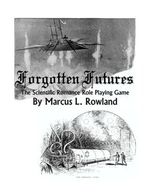
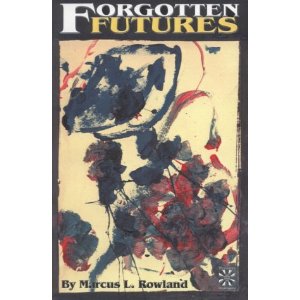
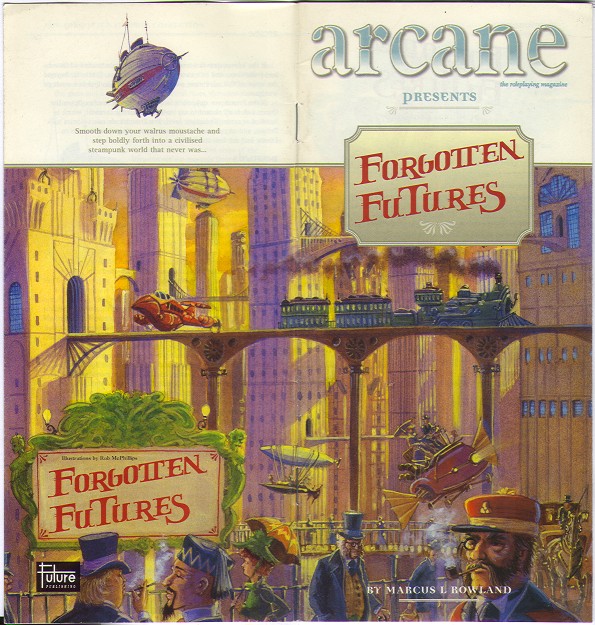
two
of the covers used. Respectively, the original edition, the print edition, and the Arcane pull-out (thanks to Mr. Rowland for the link to that one!)
Forgotten Futures is a shareware RPG. You can get it for free in HTML format (heck, you can get it for free in PDF format, if you don't mind just having the core rules and later supplements!), you can buy a CD-ROM version from Marcus himself, or you can get the print edition (I'll be doing that Friday, just to double check all the rules are the same between those two, and possibly get some interesting artwork).
But, while all this is interesting, it doesn't really tell us what Forgotten Futures actually
is
. Or anything about the man who wrote it. On his own.
Well, let's start with the game itself, shall we?
What's All this Forgotten Futures Stuff, Then?
Forgotten Futures is the Traveller of Steampunk alternate history. Except, y'know, you can't die in character creation, there's three less stats, a lot more skills, and it mainly deals with things on earth... although, as we'll see, in some fictional futures, the victorians managed to go... TO SPAAAAACE! No, really, they did, and the means they used to get there in the fictions are almost universally crazy.
It uses fairly simple mechanics, although the character creation is a little bit complicated at times, and, much like GURPS or Traveller, you have quite a few choices, as the rules are presented to be as generic and useful as possible within their chosen framework. Currently, there are 12 or so setting books, all dealing with various fictional worlds of the Victorian Age (God Bless The Queen!), and, lucky you, you're going to get reviews of all of them.
But first, we'll have to deal with the core rules. Also, before we do so, we have to briefly discuss the dashing chap who wrote them.
Marcus L. Rowland, Hero of the Crown

Poor Marcus probably forgot he had an NTLWorld page, poor man.
Marcus L Rowland is a laboratory technician who happens to write RPG books. He was born english (in 1953), shall no doubt die a dirty saes, but, in the meantime, has written quite a few books and supplements that redeem him in the eyes of this welshman.
Oh, you actually want to know what he wrote? Well, let's start with
Trail of the Loathsome Slime
, for the Call of Cthulhu game. It's not a bad little module by all accounts, and he also wrote
Nightmare in Norway
for the same system. He contributed to the
Judges Handbook
(of the original, if nowadays obscure GDW Judge Dredd RPG... No, not that d20 pile of crap, the other one), a few other things (including stuff for Space 1889, firmly marking him as a steampunk-obsessive) and has written three original (well, sort of) RPG books himself.
You may have seen one abandoned review of an original Rowland in the thread:
Diana, Warrior Princess
. Yep, that one work alone, satirising media portrayal of history and the society of the 80s/90s gets him quite a few good points. Obviously, Forgotten Futures is another independent work, and the final one boggles the mind.
Flatland
. No, I kid you not. He somehow managed to write an RPG based on Flatland. I may take a look at that at some point, but for even daring to heft his pen toward such a tome, I take my hat off to the man.
So, Will This Be A Grovelfest, Then?
No, on the general principle that even my own rose tainted glasses have to liberally covered with brown from time to time, I am going to be as impartial as possible. For example, I can tell you right now that, providing you know your victorian literature, you're not going to see many, if any, original settings in this review. All the setting books I remember are derived fairly strictly (with the exception of adventures) from their source material.
On the other hand, he does logically extend such settings, and conjecture on details that are not clear in the writing itself (we'll see that for certain in Worldbook 2, where he devotes a section to world extrapolation).
So, I'll see you soon for the beginning of the core rulebook (PDF edition)!
An Example of Play (As in Farce)
Original SA post
Yes, I'm playing catchup here, but my second Let's Read must go on!
Forgotten Futures: An Example of Play (As in Farce)
The book properly begins, as you'd expect, with an introduction. This intro is, to the credit of the writer, concise, explaining exactly what the game is, the philosophy behind it, and the absolute basics of mechanics. I won't quote most of it, but the first paragraph is something to note:
Introduction posted:
WHAT will the future be like? Every generation has its own set of ideas and predictions. At the turn of this century most pundits thought that the mighty power of steam and electricity would usher in a new age of peace and prosperity. In the fifties the future was mostly seen as doom, gloom, and nuclear destruction. In the nineties we are obsessed with computers, and convinced that the future will revolve around information technology. Each of the earlier views was valid for its era; each was at least partially wrong. By looking at earlier guesses we may be able to discover what is wrong with our own vision of the future - and make even worse mistakes when we try to correct it!
Damn straight, brother! I was promised a personal jetpack by Tomorrow's World, and by damn, that's a mistake that needs correcting! I'm being a little unfair here, as the basic message is obviously "It's actually kinda interesting how futurists often get it wrong". Although, it must be said, we're not going to be roleplaying as a method of political activism anytime soon (I would love to be proven wrong here, though, it sounds like a fun idea), we're here for victorian science fantasy shenanigans, dammit!
It's also interesting to note that, since its creation back in '93, the system has only gone through some minor changes. It's not that the game can't be broken, it's that, in the end, it's a simple enough system to play that breaking the rules seems a bit pointless. For example, it uses 2d6.
However, after a short note about how the system has received some minor changes between versions, we get into... the Example of Play. I'm once again not going to quote the majority of this (especially since the game is free), but I will give you a summary of things.
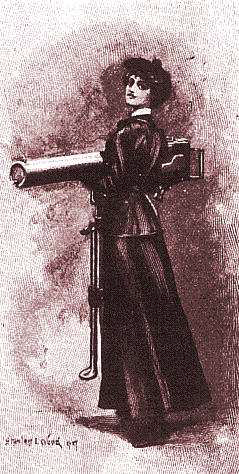
All of the artwork is pretty much either hand drawn (not great) or illustrations from original victorian magazines. This is but one kickass example
The characters are, as you'd expect, a thinly veiled collection of references and stereotypes. While Marcus is pretty cool at writing systems, when it comes to examples of play, he's no Shakespeare. For example, one player (Eric) is playing Kirk T. James (oh ho ho, ho... ho
 ) of the Confederate Zeppelin Squadron (the setting is a world where the Confederacy and Union became two separate nations, a common theme in alternate histories of Amurrca), another (Judy) is Ella Mae
Hickey
(
) of the Confederate Zeppelin Squadron (the setting is a world where the Confederacy and Union became two separate nations, a common theme in alternate histories of Amurrca), another (Judy) is Ella Mae
Hickey
(
 ), a sassy southern belle who's actually a Yank spy, and the final player (Aaron) is Horace Mandeville, reporter for
The Times
. Marcus takes the time to point out that this is, specifically, the british
Times
, which, in the victorian period, was actually a useful paper. They're all heading to a mysterious south american plateau, and a storm is brewing. I will give no prizes for guessing what happens at the end.
), a sassy southern belle who's actually a Yank spy, and the final player (Aaron) is Horace Mandeville, reporter for
The Times
. Marcus takes the time to point out that this is, specifically, the british
Times
, which, in the victorian period, was actually a useful paper. They're all heading to a mysterious south american plateau, and a storm is brewing. I will give no prizes for guessing what happens at the end.
Now, despite the terrible characterisations we'll be seeing in a bit, and the lack of imagination displayed by Marcus' players, there are some positive things about the example:
Example of Play posted:
Eric I'll try to steer towards the eye of the storm. We'll drift with it until it ends.
Bert How do you know where the eye is?
Eric In this hemisphere storms spin anticlockwise. If I veer to the left, sorry, I mean port, while moving with the wind, I should go towards the eye. Eric isn't sure, but it sounds plausible and is the sort of thing a real pilot
would know. Bert isn't sure either, but knows that 'Kirk' should understand these things. )
This, right here, is Rule Zero in action. No tedious section repeating what we already know (fudge it if you think it'll be more fun for everyone), just a simple part of the example game, basically saying "Nobody knows, there's no real rule for double checking, but it sounds plausible, roll with it". This is great.
This is not:
Example of Play posted:
Aaron I'll dictate a mood piece about airsickness instead. Let's see, how many different synonyms for the word “vomit” can I use... (starts to write list)
Judy Ugh. Don't read it out loud.
Bert Definitely not.
Yeah... there wasn't any real need for this, although this does support the idea that this was an actual example of play... only real people would troll this hard. To give a little context, Bert (the GM, or "Referee", as the game puts it) basically said "Nope, you can't describe how brave Cap'n James is because you're still airsick in your cabin".
Players, eh, what can you do?
Example of Play posted:
Bert Roll for luck, to be there at the right time ..um... difficulty three. (Aaron rolls a 2, a success) OK, you get up and stagger forward in time to meet her.
Judy I bat my eyelashes and ask him to carry my first aid kit.
Aaron (speaking as Horace) Delighted to help, Miss Hickey.
Bert You reach the bridge. Kirk is still at the wheel, and his forehead and arm are obviously badly gashed.
Judy (as Ella Mae) Mah hero, you've saved us all!
Eric (as Kirk) Shucks, it was nothing ma'am.
Despite any possible versimilitude to the accents, for this particular section, I would suggest only skimming. The interaction is not great, and the in-character dialogue is notable for its levels of awful. It also doesn't explain the rules, but this is sort of okay, because the whole of this book is pretty much rules.
Now, to give you some idea of the hilarity you can have with a steampunk game, here's Marcus' idea of a spy-camera:
Example of Play posted:
Judy When I pack my first aid kit afterwards I'll use my spy camera to take a picture of the maps on the bridge.
Bert The camera concealed in your hat? It's the first chance you've had to use it, isn't it?
Judy Uh-oh. Yes, it is. I have a bad feeling about this...
Bert There's a loud whirring click, and the artificial flower at the front flaps out of the way, like the door of a cuckoo clock. The lens pops out on a concertina bellows and clicks, then retracts again. It takes two seconds.
As the players note... reaaaaal subtle. Now, you might be mistaken for thinking Marcus (or Bert) is of the old-school "adversarial" style of GMing, but no, the difficulty for spotting this is fairish, and everyone except the reporter fails. I'll save you from the rest of the example, but you now get to find out if your guess as to what happens next was right.
Ready?
Example of Play posted:
Bert Good thinking. Now, you seem to be in fairly clear air, and something big has just flown past the windscreen.
Judy Another Zeppelin?
Bert You're not too sure, but it looked like a pterodactyl....
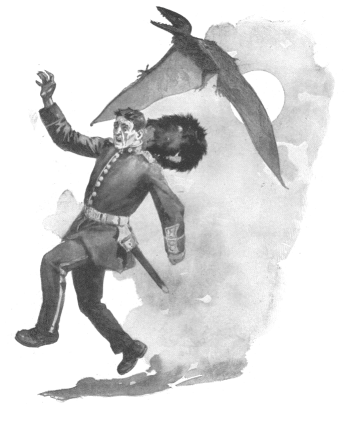
Oh, you victorians and your exotic pet fetish!
Ayup. Lost World on a hard to reach Mesoamerican plateau. You never saw it coming. Unless you're genre aware, in which case, you can't move through jungles without tripping over god-damn lost civilisations and mad scientists.
On the one hand, this example of play isn't great, even considering some of the examples we've had in this thread... on the other, it does the job. It gets across how the game will go, and the average player's expectation: To have a rollicking good time in a jolly world that existed in the minds of victorian authors, pip pip!
To finish up, there's a section what you need, a glossary of terms for the roleplaying impaired, and the acknowledgements.
What you Need is notable, because the requirements for this game are pretty light. 2d6, character sheets, rulebook. And believe me, the system's fairly easy to memorise, so we're not too worried there. The acknowledgements, on the other hand, are quite interesting, because they include some people who you may know. Here's a short selection:
Jack Cohen : I'm assuming this is the Jack Cohen who co-wrote "The Science of Discworld" and "Evolving the Alien" with Ian Stewart. I may be corrected later today.
Dave Langford : Author, editor, critic, mainly does sci-fi, and has written some cracking stuff.
Charles Stross, Brian Stableford : If you don't know who they are, I'm going to smack you upside the head.
That all of these people contributed ideas/editorial comments will be of note when we begin tackling the rules... which will actually be our next update, as we make a character!
Making A Rollicking Chap
Original SA post Forgotten Futures: Making A Rollicking Chap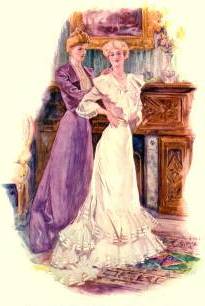
Some victorian art depicting a lady. This illustrates the example Mr. Rowland gives, which is not in this update.
And so, we come to the character creation rules. It's a little dry to read, but that's just fine, as it still has important information. For example:
”Character Creation” posted:
Sex (Male or Female, and [optionally] sexual orientation) may be important in some game settings. Most scientific romances are based on ideas current in the early 20th century, and there are very few prominent female characters, apart from swooning maidens and an occasional competent scientist's daughter. It is rare to see a woman attain any influential business or academic status. In this setting a male adventurer is probably most useful. In a civilisation derived from a successful suffragette revolt women might have all the power, with men down-trodden or enslaved. In most scientific romance settings homosexual characters will encounter severe social problems.
Age is usually unimportant for adult characters; exceptionally young or old characters may be at a social disadvantage, otherwise there is no effect in game terms
There was once an article on this subject, by the briefly infamous Jonny Nexus. Have a read . In any case, this is rather important, but the entire section leaves a lot of the actual adjudication to the GM. For example, professions. Want to be a filthy rich dandy with no work? GM may, or may not allow it, but there's nothing inherently in the rules to stop you.
So, here we come, to the actual character rules themselves. Essentially, it's stats, skills, (optionally) advantages, and (sort of optionally) kit. Except the kit is usually in the setting books, as opposed to this core rulebook. The game uses a point buy system for character generation, and Mr. Rowland recommends 21 points (17 or 18 for lesser people, 25 or 28 for unusually competent types). These points are for everything that isn't kit. Luckily for you and me, there's not a whole lot to deal with. Let's start with the stats.
There are three stats, BODY, MIND, SOUL. That's it. In some settings, there's a fourth (MAGIC, which can end up with magic users being weaker characters, and you can replace it with other optional stats), but we won't need to deal with that right now. Stats generally go from 1 to 6, with 7 only existing on GM allowance. This will become important later. For now, let's show off the costs, and start with this character, shall we?
pre:
Stat 1 2 3 4 5 6 7 Cost 0 2 3 5 7 10 14
Then we come to skills. They generally come in four flavours of numbers, being Stat, Stat/2, Average of Stats, and Average of Stats/2. Two of the skills, Brawling and Stealth, come for free, although they can be improved, and Mr. Rowland shows his mercy by allowing us to buy levels in a skill at 1 point per rank, although you need to buy at least 1 point to actually have the skill.
Skills are quite generic, and cover wide areas. For example, Scientist covers the use of pretty much any science, both making it easier for characters to be useful in play and reflecting the relative ease of learning multiple disciplines back then. It's by no means a perfect system, but it is quick. Let's continue with my own example:
Malcolm Vandebilt isn't really going to be either a fighting or a sneaking type, so Brawling and Stealth remain as they are at the free level, being BODY (2) and BODY/2 (1) respectively. He's got 11 points left, so he's rather spoiled for choice, but we know he needs to catch mediums and snake-oil salesmen in lies, and, looking down the list, Psychology fits the bill. Just 1 point would get us a level of 5 in this (Average of MIND and SOUL rounded up, plus 1 point), but we'll take 3 points, just to be cautious, for Psychology 7.We go back to the beginning of the list and work from there, taking Actor 2 (6), Detective 2 (6), Scientist 2 (6), Scholar 1 (5), and Thief 1 (3). The Scholar skill gives us 3 fields of knowledge (Skill/2 rounded up), so he's an expert in Conmen & Cons, Famous Stage Magicians, and, to round him off as a person, Board Games. We're effectively done already.
Now, before we wrap this simple update up, a few optional rules and notes. You can, as an optional rule, ask people to spend some points on qualities like being rich, owning something rather expensive, or having a title, up to a maximum of 3 points per type. Points can also be saved for either improving rolls later on, or improving skills during play, and these points are doubled, then saved as Bonus Points. These are basically a combination of experience and roll modifier points, and it's recommended you should give between 3 and 6 per adventure. The example for something that's worth a bonus point is definitely worth a quote, though!
”Nice example!” posted:
1st player: “I say, isn't breaking and entering illegal?”
2nd player: “Don't be silly, we're gentlemen!”
Special thanks to Nathan Gribble for this gem.
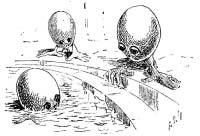
Moon people at the end of the character generation rules. Never let it be said you can't make a moon person in this game!
Another thing of note is that the chapter isn't always clear on some things. The main example is that of skills. “Skills are based on one or more characteristics, to which at least one point must be added”, for example, is the exact wording that kicks off how to calculate skills, and it's a bit ambiguous. It implies that points must be added to all skills, which is kind of silly considering some of the skills, but, to be fair, all but the most stupid GMs are going to get the gist. It's still ambiguously worded, though, and I'm often against such things in rules, especially chargen.
So, to sum up, here's our own example character
pre:
Player Name: JamieTheD
Character Name: Malcolm Vandebilt
Profession: Stage Magician and Debunker Age: 32 Sex: Male
BODY: 2 Skills
MIND: 4 Actor 2 (6) [Av. M & S]
SOUL: 3 Brawling 0 (2) [B]
Bonus: 0 Detective 2 (6) [Av. M & S]
Psychology 3 (7) [Av. M & S]
Scholar 1 (5) [M, Conmen & Cons, Famous Stage Magicians, Board Games]
Scientist 2 (6) [M]
Thief 1 (3) [Av. B & M / 2]
So, with that concise system for making characters out of the way, I'll see you next time for the skills, and maybe some actual rules!
Lifting Elephants With Pneumatic Dungarees
Original SA post Forgotten Futures: Lifting Elephants With Pneumatic Dungarees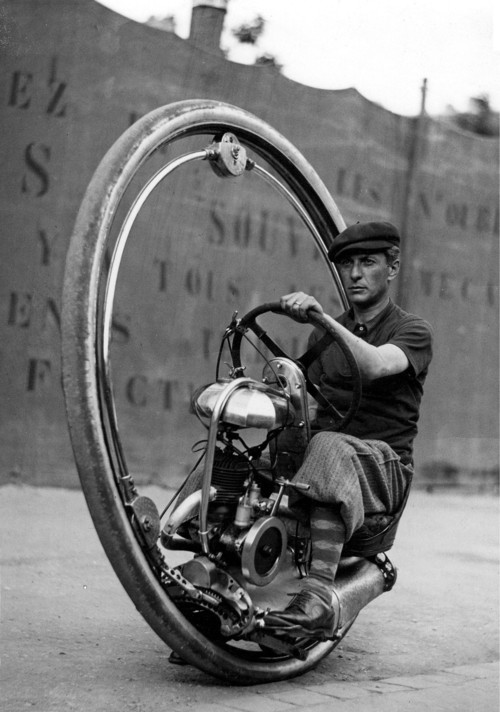
Just like Fading Suns, no real art in this section, have a cool picture of a monowheel instead!
The task mechanic for Forgotten Futures is quite simple, although you'd be forgiven for thinking it's a bit more complicated, considering that a) It's after a half page lecture on what the stats are (BODY = What it says on the tin, MIND = What it says on the tin, SOUL = Interpersonal stuff, instinct, arty stuff), and b) Mr. Rowland doesn't word it amazingly well:
”Rolls By Rowland” posted:
To do anything roll 2D6:
• Add the characteristic, skill or Difficulty to be overcome.
• Subtract the skill or characteristic used.
• If the modified result is 7 or less it's a success. However:
• A roll of 2 ALWAYS succeeds if the skill etc. to be overcome is 8 or less.
• Any roll of 12 ALWAYS fails, regardless of modifiers, and may have additional unfortunate consequences.
I'm not going to overanalyze this, basically just put it in a way that's much simpler:
”Jaysnotes Version” posted:
2d6 + [Difficulty, Opposing Characteristic, or Skill] – [Your Skill or Characteristic].
Is it 7 or less? If so, well done, you did it.
Is it natural 2, when [Opposite Thing] – [Your Thing] < 8? Well done, succeeds!
Is it natural 12?CRIT FAIL!

If [Opposing Thing] – [Your Thing] => 8 , don't bother rolling, it won't happen.
See? Nice and simple. That's really the whole mechanic, and, to be fair, it works. There are a few situations where it needs a bit of twiddling to work, but Mr. Rowland has you covered. For example, very big numbers don't fit very well on a 2d6 roll. Don't worry, just divide both Attack and Defence by the same number until they do! This is, as he notes, vital when using vehicle combat, and does slow vehicle combat and other large number tasks down a tadge, but, considering it's pretty much “do this light sum after rolling” for literally everything , it's nothing to complain about. The best, and most hilarious example sums it up well, although it has a typo. Can you spot it?
”Marcus' Hilarious Example (Level 1 Cantrip)” posted:
Example: Tom Sloth And His Pneumatic Coveralls (1)
Tom Sloth, the brilliant but somewhat misguided engineer, has developed a mechanical exoskeleton which can be worn over normal clothing. It looks like a pair of silver coveralls, and will theoretically let him lift things as though his BODY (normally 5) is 30. He decides to test it by lifting an elephant at the zoo. The exoskeleton attacks with BODY [30], and the referee has decided that lifting an elephant will be difficulty 20. Neither number is under 12, so he divides both by 3 to make them fit. Now the attacking force is 10 and the defending BODY rounds up to 7. On a 3 Tom lifts the elephant; unfortunately its weight is now attacking his ankles and wrists, which aren't boosted by the power of the coveralls... BODY 10 is attacking Tom's unmodified BODY 5; the weight will cause him serious harm on an 11 or less!
If you guessed “Hey, unmodified because the ankles have the weight of an elephant on them!”. You win your Super Special Rules-Grognard Pedant Points! In actual fact, BODY 10 (Elephant/3) would be attacking Tom's BODY 2 (5/3 rounded UP), making the situation far, far worse for Tom's poor ankles!
There's also rules for doing something if you aren't skilled, and you win in a GM Bullshitting Contest vs GM Paranoia (no roll, just bullshit better than he can), but the long and short of that is: Don't Do It Unless You Have No Choice. Long term stuff is pretty much the only type of extended roll you're going to see, with the GM arbitrating how many successes are needed, difficulty, etc, and failures adding to the time spent. Finally, bonus points can be spent before you roll to improve your chances. Now, how does all this apply to combat, and what's the damage system?
Well, that's not until the update after next, although Marcus helpfully informs us how to improve our skills, which skills are difficult, and what the skills are. Those will be handled next update, with a slap on the wrist to Marcus, as what skills do should generally go in Character Creation, and going “Improvement of Skills → Wound Modifiers (after skills) → Combat Rules” isn't exactly the best organisation. Still, on the upside, the examples are well worth a read in this section (pages 12 to 18), as they show a good sense of humour, and do actually demonstrate the system quite well!
Next update, we look at how to buy and improve skills, and what those core book skills actually do !
Oh, Dem Skills!
Original SA postPurpleXVI posted:

I have no fucking clue what's going on here
Nah, it's a mage duel between Boobs McGee (The 80s grognards favourite spellcaster!), Angry McOgreson (who's being charmed or somesuch), while Kobolder McSneakyFuck is defying stereotypes by blasting both their dumb asses with lightning.
Oh, wait, there was something I was meant to be doing, wasn't there? OH YEAH, VICTORIAN SHENANIGANS TIME!
Forgotten Futures: Oh, Dem Skills!

This man rolled a natural 12 on learning Detective. Hence the glasses
Improving skills is actually a fairly simple matter. You spend bonus points equal to the next level of the skill, make a roll against it, and... wait...
”Da Rules” posted:
• If the result is a success, the skill has been improved.
• If the attempt is a failure, but the dice roll is not a 12, the character loses the points but does NOT
improve the skill; more training is needed. After some more experience (another adventure) the player
can try again. This can be repeated until the skill has been improved. A skill's rating may not be
improved more than one point per adventure.
• If the result is a 12 the character has “peaked” with this skill; she loses the points, does not improve the
skill, and CANNOT improve it at a later date.
Italics are my emphasis. Oh, deary deary me. I'd personally have made that one an optional rule, because the XP wastage is bad enough if you fail, but never being able to raise a skill? I can understand why someone might think that's a good idea, but... Yeah, I can definitely imagine players getting mega frustrated if this happens on an important skill for their campaign (say, Brawling), the first time they try to level it. And keep in mind, this could happen regardless of how high your skill is, because he's referring to a natural 12, a 1 in 36 chance. Per skill level.
Learning a new skill has a similar “Can't let you do that, Starfox!” on a natural 12. Added to that, it now appears there's been a bit of confusion and ambiguity again folks! Now, when we talk about ranks, as players, we generally mean “Them points wot we add to our stats to get skills”. However, for the purpose of skill improvement and learning, it's actually the total value, so our intrepid hero Malcolm Vandebilt would need to spend 7 points to improve his Actor skill, and if he wanted to learn, say... Business, he'd have to pay 10 points (his MIND+1, the minimum rank of the score) to even try. This generally seems to lead to a default training roll of 2d6+1, and remember, 7 or less to succeed, and if it's a natural 12, you can never learn the skill!
Obviously, learning, whether to improve a skill or add one, takes time. This time is never specified however, so we'll assume “Random downtime”. Oh, and before I move on to skills, Scholars and Linguists can add fields of knowledge or languages by improving the skill by a point. They can only add one language per adventure, however, and presumably (although it's not explicitly mentioned), only one field of knowledge per adventure too.
Now, we move onto the base skills themselves. A few of these are difficult skills, and I'll add a (D) before them. Difficult skills, Marcus tells us, are not be learned like normal skills, only being allowed to be learned after some major event or whatnot. Considering that these skills include things like Doctor, I'm generally down with that. All skills encourage you to specialise in them, to make sure your character isn't Broken McEveryman, the Amazing Know-It-All of Leicestershire. There is no mechanical benefit to specialities, just a limiting factor to stop you being overpowered. Tellingly, there's also little to no guide as to how many specialities you can have.
Actor (Av M & S) – This is basically the generic “Stage performance” skill. Players are recommended to focus this into one school of acting, like Opera, or Ballet. It's also the generic “Pretend to be someone else” skill, which slightly conflicts, but hey, let's roll with it.
Artist (Av M & S) – Again, generic art specialisation, and you're recommended to focus this one too. Focusing a skill doesn't have any real effect, but it does delineate what the character can and can't do for the poor overworked GM.
Athlete (B) – Everyone knows what this skill does. It's the one used when you're climbing or trying to run faster than the other guy being chased by hungry velociraptors. Not a must have, but still useful, considering that Victorian times could get a fair bit physical!
Babbage Engine (M) – Victorian computers. Of limited application in most settings, but still important in others. Ask your GM about whether this one's going to be needed for anything before taking it.
Brawling (B, Free at start) – The skill of hitting things rather hard. Pugilism, fisticuffs. Everyone gets it, so chill.
Business (M) – Ah yes, the skill that's of limited use outside political and/or long term campaigns. Covers business, politics, and the like. Can apparently be useful for forging papers, according to Mr. Rowland. I can kind of understand why, but most players probably won't take this.
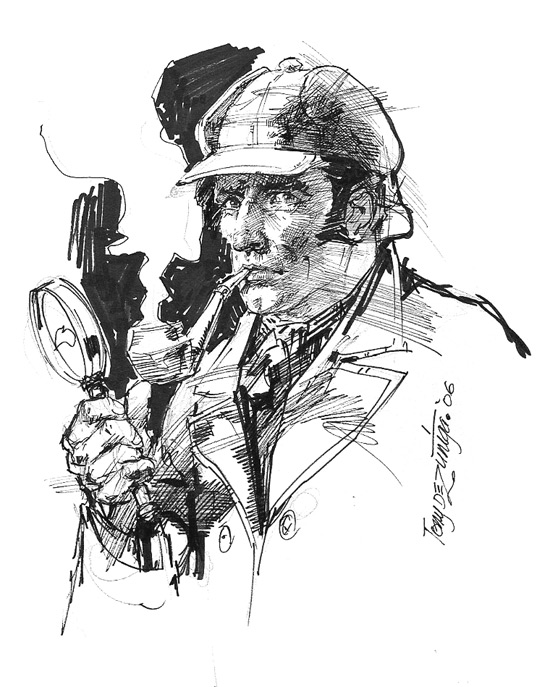
He Has Detective [20] and Martial Arts (Baritsu) [8] or something, honest! :P
Detective (Av M & S) – The generic “Spot shit, get a clue” skill. Can also be used for interrogation and deduction! A generally useful skill.
(D) Doctor (M/2) – This is sensibly difficult, as Marcus points out that a lot of people with this skill sort of got it by going to a medical school for some years. With this skill, you can sawbones people.
Driving (Av B & M) – The ground vehicle skill. Like all skills, a specialty is recommended, although most Gms I met ignored that. Robur the Conqueror presumably has this skill.
First Aid (M) – Patching people up before sending them to the pros... or just patching them up. Also the midwifery skill, which would no doubt result in much hilarity.
Linguist (M) – Speak shit. You speak one language per two levels of the skill, and can add another for 1 point, up to your Linguist rating. Obviously, your native language doesn't count, as you automatically know this.
Marksman (M) – Shoot stuff! Yay!
(D) Martial Arts (Av B & S/2) – Ah yes. Why is this skill separate from the normal “hit things” skill? Because victorian brits were fascinated with the chinese, that's why! Martial arts are difficult, requiring you to spend years with some little old bald man who knows kung fu or something, Martial arts are more powerful than just hitting things normally, so some house rules are recommended to make them less broken. Like requiring weapon martial arts and unarmed martial arts to be learned separately, or not allow martial artists gun skills. We'll see whether it's actually that broken soon enough.
Mechanic (M) – You tinker with things. Good for you!
(D) Medium (S/2) – Obviously, this requires you to either be a genuine medium, to have the talent and learn from a genuine medium, or to get thrown in the deep end with the talent and somehow stay sane with all your ghost bros begging for attention. Generally not a useful skill in most settings, except as plot fodder. It was presumably included because, once again, Victorians ate that shit right up.
Melee Weapon (Av B & M) – Hitting things with sword canes and the like. Surprisingly not often used, as sword duels were sort of phasing out of victorian society, and rifles and other such fun stuff were really beginning to come into their own.
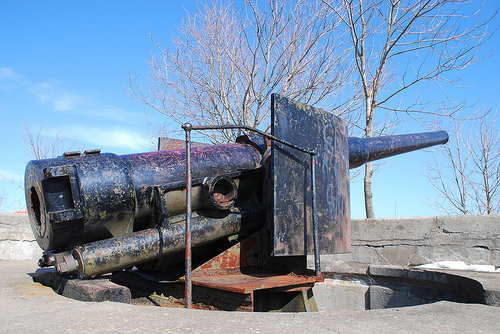
Military Arms: You too can shoot one of these!
Military Arms (M) – Calculate someone's position relative to you, pull some levers, hit them with a 500 pound shell from fifty miles away. The artillery skill, but also the gunnery skill and demolitions skill. Basically, anything not an obvious infantryman's weapon.
Morse Code (M) – This was a thing in victorian times, you maybe want to learn it. If you're a soldiering or piloting sort of chap, you definitely want to learn it.
(D) Pilot (Av B & M/2) – Flying shit. Need I tell you how this one is kinda tough to learn? Doesn't require years, but still needs a competent teacher and significant downtime.
Psychology (Av M & S) – Combination “Sense Motive” and “Influence” type skills. Make friends, influence people, tell them they're lying, and be right about all of the above. Oh, and you can presumably charge vast amounts of money for confirming someone's very very sad.
Riding (Av B & S) – I say, are you a proper gentleman? Then why aren't you skilled in riding some form of quadruped, old chap? Bloody foreigners, I tell you... All noble types need to at least pay lip service to this skill, honest!
Scholar (M) – The :sperg: skill. Know shit about random shit that isn't covered, but might be important. All specialisations must apparently fit a single group of knowledges, such as Archaeology or somesuch. As both player and GM of Malcolm Vandebilt, I rule his Board Games fit perfectly fine with the rest of parapsychology, because servants hidden inside so-called Mechanical Turks were a well known trick of the time (after that one had been exposed). So there.
Scientist (M) – Pick a field of the life or earth sciences, such as biology, chemistry, or astronomy. You know it. Good for you. Now add all the rest, because Victorian Science was a lot messier and more holistic than more recent science, due to knowing less and dabbling more.
Stealth (B/2) – This skill is both marked as difficult and given for free to everyone... MAKE YER DAMN MIND UP! If you don't know what Stealth does, I can't help you. Nobody can help you.
(D) Thief (Av B & M/2) – Okay, this one is legit difficult. You ever lost your keys and had to pick your front door lock? I have! It takes someone who knows skullduggery and months of training to learn, Then you know stuff about nicking stuff.
So, that's all the base skills! Next time, we handle Wounds and Combat, WOOO! THE GOOD STUFF! Maybe.
Wounds & Basic Combat pt. 1
Original SA post
Yeah, RIFTs... Next to no balance, and good luck finding a rule! Oh, well, let's try something a little more clear. A little.
Forgotten Futures: Wounds and Basic Combat Pt. 1

Did I mention the art's a bit sparse for this game? 'Cos it is
So now we come to the combat and wounds rules. The wounds rules are relatively simple, but the combat, obviously, isn't that easy, So Mr. Rowland sensibly goes with wounds first, let the explanation for how they come about come afterwards.
Essentially, wounds come in five flavours, Bruise (B), Flesh Wounds (F), Injuries (I), Critical Injuries ( C ) and KO's (KO, obviously). Each wound is an entity unto its own, requiring separate healing. Obviously, this makes healing quite tough, but wait, it gets better! Bruises are fine, you can have fifty million of these, and there'll be no effect beyond making you black and blue
all over
. Not quite realistic, which seems to be what the system aims for, but it's a moderately sensible rule that cuts down on bookkeeping. They also don't have any (long term) mechanical effect, so whoop dee doo for Bruises, folks!
Flesh Wounds are a little more serious. If they're not treated within a reasonable time (this is, as is often the case with Forgotten Futures, left up to the GM) they can open up and become proper Injuries. They take a week to heal naturally, and are difficulty 4 to heal, twice the difficulty of Bruises (which take a day to heal). You can have several flesh wounds, and each, as I've mentioned, is treated separately, leading to increased risk of Injuries. This is a bad thing, as we'll see in just a moment.
Injuries are for the serious stuff. One of these, and you're penalised fairly badly for doing things. Two of them, you can't move or run,
three
of them, and they combine to form VOLTRO- No, wait, wrong one, they combine to form...
Critical Injuries
. These, obviously, are an extremely bad thing, meant to represent life threatening wounds. As you'd expect, having a Critical Injury means you're going to die if you don't get some treatment quickly. Again, Marcus is pretty vague about this, expecting the GM to adjudicate based on type of injury or something. Anything from a few minutes to an hour at best. To give you some idea of the life expectancy of a player with a Critical Injury, one of the examples for a normal Injury is “punctured lung”. So I'd probably skew it toward the “minutes” end of things. Obviously, someone critically injured is also knocked unconscious.
Knockouts are... well, what it says on the tin. It lasts 6d6 minutes, regardless of the type of knockout used. Eh, considering combat rounds are 5 seconds apiece, that's effectively out of the fight no matter what.
So, as you might guess, combat is a bit brutal. Every wound above a Bruise adds a penalty to BODY and BODY related skills (yes, that includes the Average ones, fool!). So now we get to healing. Healing is relatively simple: First Aid doesn't actually heal anything, being a prophylatic against wounds getting worse. Roll versus the difficulty of the wound (remember, each wound is separate!), and you'll have used something, even just your brain, to stop the injury from getting any worse. It's at least implied that
all
wounds can get worse, which makes little sense for Bruises and KO's, but hey, let's just assume Flesh Wounds and above are the ones that get worse, a'ight? Roll your BODY versus the wound recovery, for each untreated wound (again, no specified time), you fail, it gets worse. Easy.
Doctor, unlike the magic medical skills of other games, only acts as First Aid and, with the proper facilities, bed rest, and presumably by serving godawful food, helps someone heal slightly faster. You make the roll versus the recovery roll, the time needed to recover from that wound is halved. Considering that if the player cocks up their recovery roll (BODY v Recovery Diff again) the time they're meant to do it (the end of the recovery period), they have to wait a full recovery period (or need another check from their friendly Doctor to halve it again) gives you a good incentive to play it safe and not get wounded.
Want to know what else gives you an incentive not to get wounded? The basics of combat! We'll be getting into the more crunchy stuff later, but for now, here's Mr. Rowland with the basics! Take it away, Marcus Rowland!
”Basic Combat Stuff” posted:
A combat round is a period of approximately five seconds in which combat occurs. In this time punches might be exchanged, shots fired, and so forth.
The following things can be done in a combat round
1. Movement: A normal human can walk about ten feet, or run twenty. On a Difficulty 6 BODY or Athlete roll, or on expenditure of a bonus point, this can be pushed to thirty feet.
OR
2.An action, such as ducking for cover or opening a door. Referees may OPTIONALLY allow two actions, or an action and a movement, in a round; for instance, opening a door and diving through.
THEN
3.An attack, or several attacks with some weapons and skills.
THEN
4.Wounds take effect.
Keep in mind, all actions in a combat round happen simultaneously . Oh, what fun we'll have! But we'll have to wait for the actual combat rules for next time!`
How to Get the Other Guy (Combat Part 2)
Original SA post
Two short updates incoming, then both RPGs I'm covering will have had their combat covered! Woo!
Forgotten Futures: How to Get the Other Guy (Combat Part 2)
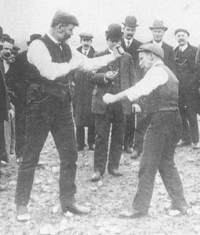
Two chaps fighting. Again, this section has no real art to speak of.
Last time, we'd discussed how getting seriously hurt in Forgotten Futures was a
bad
thing. Unlike the other system I'm reviewing, Fading Suns, there are no magical elixirs or tonics to save you from a messy, violent, and painful end, even at the hands of Bob McPeasant, the most NPC NPC ever to NPC. The system for actually resolving attacks is quite simple, using the system shown earlier in the review to make an opposed roll of sorts. To sort of recap it, it's effectively 2d6 + [Defending stat/skill] – [Attacking stat/skill]. Roll under 7? You did good. However, it mentions something that we've not seen before. Effect of the Roll? What the heck is that?
Well, when you actually hit, you make a second roll with the Effect number of the weapon against the body (actually finding the number needed on the table in the skill chapter this time), and, depending on that roll, your weapon will have one of three effects. For example, standard fisticuffs have an Effect of B, B, B/KO. Obviously, looking at injuries, this means that a failed roll gives a Bruise, a success gives a Bruise, and a great roll gives a KO
and
a Bruise. This makes fists somewhat useless with RAW, unless you're into subdual, you dirty sod, you! Meanwhile, every single melee weapon or gun can kill on a good injury roll. Not always, but... well, a Club has injury effects of Flesh Wound, Flesh Wound, KO/Kill. Wait, what?
Yeah, this requires a bit of extra explanation. When an injury effect entry is split, it means you make a second injury roll, same numbers. If it hits, it's the latter type, if it doesn't, it's the former. One person gets a good injury roll with a weapon on you (or rather, a pair of them), and it's Goodnight, Gracie! So, to sum that bit up,
really
don't pick fights.
There are also all sorts of modifiers to your To-Hit, which includes autofire, for a modifier of... -1. Why? Well, let's let Marcus explain:
”Mr. Rowland on MGs” posted:
One modifier may need explaining, since it is frequently misunderstood; machine guns are a little less accurate than other firearms, but more than make up for it by firing LOTS of bullets, increasing the chance of a hit over that for a normal gun. This is the main reason why automatic weapons are used. The idea that machine guns rarely hit and do less damage than other firearms is a myth. When used for single shots they are no less accurate than other weapons of similar size. However, many machine guns of this period cannot fire single shots, the minimum is a burst of two or three shots.
Marcus Rowland helps people out with science for a living, and studied all sorts of victoriana and other stuff for shits and giggles. We do not argue with Marcus, and nor should you.
Now, it's under a separate heading, but one really should mention Pulling Punches and Aiming to Wound. By taking a hit to your attack roll, you can either hit softer (only results of Column A or B apply) or hit harder (Only B and C apply). It is slightly more difficult to do the latter than the former. Also in the interests of realism, Marcus also mentions that using machine guns to spray and pray does not necessarily work that well, and gives us some crunch to go with it. It's not too nasty, but it basically makes it extremely difficult to murder more than 3 tommies/russians/evil henchtypes in a go. Certain aspects of combat in Forgotten Futures are, it's true, brutal... but nobody's an invincible death machine. Nobody.
Hit locations also exist, as an optional rule, but again, one cannot use MG's or grenades with called shots. That is all that needs to be said on that subject. Now, before we wrap up combat (which is simple, and often short), let's talk a bit about armour, and some of the example weapons. Armour is quite simple. It lowers the Effect of weapons, but is incredibly conspicuous, and, obviously, local authorities will become quite suspicious of anyone wearing such things anywhere more peaceful than a warzone. In other words, GM's are encouraged to discourage the players from using the stuff, because dammit, the victorian heroes didn't use it, they were True Blue Europeans!
No, that's not actually the main reason (the heroes thing, that is), but it's still mentioned. It's because it's an easy way out of the consequences of combat. And Marcus is about nothing if not realism in his system. Well, for the combat and some other stuff, at least... we'll get to the zeps and electric pentacles and the like much, much later, probably all under the heading of "Victorian Sci-Fi, What Up!"

Do not screw with Tripods. You Will Lose.
Now, we move onto the exotic and alien weapons that Marcus uses as examples of interesting things to place into the game. The exotic weapons include the Radium Gun (from the Edgar Rice Burroughs martian tales... y'know, John Carter? No? Philistines), the Disintegrator (which, judging by its Effect of fifteen , does what it says on the tin), and the Minigun (from... Terminator 2. Wait, what? I've got images in my head of an evil, nation spanning Babbage Machine creating clockwork men in my head now! Long Live Clocknet!). Then, for an encore, he creates the really deadly stuff. Just four things, but they're still pretty deadly. For example, the Heat Ray and Black Smoke (from War of the Worlds ) are included, and both their B and C results are death! A nuke is also included, with the note “Not Recommnded!” (Hehehehehehe!), and, finally... a Stun Gun. Whoop dee doo... it does what it says on the tin most of the time, unless the roll fails. Nearly every piece of kit has a fair chance of murdering the shit out of you, be it normal or exotic.
So, I say again... try not to fight, the combat system is quite, quite brutal!
A Foreigner You Say?
Original SA post Forgotten Futures: A Foreigner You Say?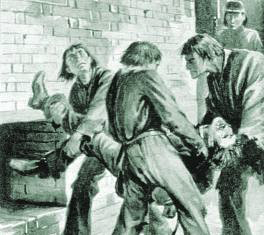
This man ignored the guidelines.
I'm going to skip the various animals and extra guns, and go straight to the next section, because, in a game full of “Things of note”, this is where the fun happens, because it's the Roleplaying section. That's right, the bit where we're told about possible concepts, bad habits, and... wait, bad habits? Wait and see, that one's an interesting one.
The section begins with various stereotypes/archetypes of victorian/edwardian times that players tend to fall into, and it's written quite well. For example, social mobility? Forget that shit, even though the Protestant Work Ethic is a thing with the middle class... the Working Class folks know that they're never going to be a toff, no matter how hard they try. Meanwhile, gentlemen are impeccable and always honest (honest, guvnor!), women who adventure are looked upon with suspicion (bloody Pankhursts), and foreigners?
quote:
I Say, He's A Bally Foreigner...
Chauvinism, in its original meaning, is rampant. People don't necessarily hate foreigners, but they do treat them as mental and moral inferiors. To quote a satirical treatment of this attitude, from H.M.S. Pinafore:
For he might have been a Roosian,
A French, or Turk, or Proosian,
Or perhaps Itali-an,
But in spite of all temptations,
To belong to other nations,
He remains an Englishman!
Hurrah!
For the true born Englishman!
This disrespect for foreigners was true of most nations, especially Britain, while harsh treatment and exploitation of “savages” was typical wherever “civilised” nations were expanding into “primitive” lands; in India and Africa, the Middle East, North and South America, Australia, and the Pacific.
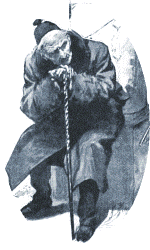
Arr, zurr, times bain't what they used to!
Meanwhile, Marcus takes the line that sex is not to be described in game, no-way, no-how, because that's not how victorian science-fiction did it. To be fair, he's correct, as SF-Porn didn't come into it's own until the late 60s at least. But then comes the piece-de-resistance. How people speak in a victorian game:
”Talk Tidy!” posted:
Arr, We Talks Loike This....
Speech is usually fairly formal, and is of course always polite. Accents are stereotyped; in Britain members of the working classes always have lovable Cockney accents, or impenetrable country dialects, while the upper classes all have Oxford accents. Scotsmen say “Och aye”, “The noo”, and “Hoots mon”, Welshmen “Look you” and “Boyo”, Irish “Begorrah” and “Saints preserve us”. America has its own stereotypes; Harvard accents for the upper classes, Brooklyn for the dregs. Only criminals and drunkards swear. Finally, here are three examples of good and bad roleplaying in the context of these rules. Can you tell them apart?
“I say, old chap, can you direct me to the station?”
“Yo dude, where do I catch the iron horse?”
“Excuse me, my Lord, a gentleman from the police is at the door.”
“Hey boss, it's the pigs.”
“I'm afraid we're in a bit of a hurry. May we get by, please?”
“Out of the way, you ***ing scumbags, we're on a mission from God!”
To be fair, playing some filthy sky-pirates as the GM and mentioning that last line would probably get some cheers. But still, it's an amusing segment. In short, Marcus expects you to stereotype to the hilt in the name of fun. Personally, I'd say a more measured approach would be better, having also read victorian fiction, but still, it's a section that amuses me, and I remember a time, many moons ago, where I would have taken this advice literally.
Then comes running adventures, which is the usual thing, and a big ol' bunch of NPCs for you to play with. No, really, a lot of NPCs. Still, the advice in the section is good, for the most part (long-ass exposition and railroading bad, clarity good), and Marcus keenly identifies a need that is not always catered for in lists of NPCs. Sure, you always have librarians, thugs, and police officers, and Marcus provides those, but how many RPG writers provide us with a pre-made “Little Old Lady”, eh? Eh?!?

Not a little old lady, this is Stokes the Evil Retainer, another NPC.
”LITTLE OL' LADY” posted:
Mrs. Jenkins , The Little Old Lady, is always useful as an unreliable witness to unusual events. She's unhelpful, inclined to call the police at the first sign of trouble, and always complaining.
Quote: “He's the one!” (points at a completely innocent character)
BODY [1], MIND [3], SOUL [2], Detective [8]
This character is also useful as a telephone operator, receptionist, or librarian.
You're beginning to see now why I heartily endorse Forgotten Futures. Next time, Attention To Detail . No, really, the next chapter will blow your socks off.
And Now For Something Realistic
Original SA post Forgotten Futures: And Now For Something RealisticSo, you thought you'd gotten away from crunch, eh? Haha, nope, nowhere near! The organisation for Forgotten Futures (PDF edition) isn't bad , per se, but it could definitely use some work, as Gming is after rules (kind of sensible), and weapons are at the end of the combat section (again, sensible, but, as we'll see, a little disorganised). So, we've got most of the crunch out of the way, what's left?
Well, for a start, a list of Forgotten Futures books, and “maybe you should try these” recommendations of Marcus' other work, including two I'd not really noticed before now: Mummies: The Next Generation (a sub-setting of Forgotten Futures not covered in other media, only available from the CD ROM... which he still sells), and Bartitsu! A short article about the creator of that obscure martial art, Bartitsu (known to Sherlock Holmes fans as Baritsu).
And then, things get interesting.See, decimalisation didn't happen for a long-ass time, so those Kilograms and Meters and nice, sensible money? Didn't exist in the Victorian period.Instead, you have to deal with currency as it was then... 12 pence to a shilling, 20 shillings to a pound, and, for larger jobs, you'd be paying or writing cheques in Guineas (21 shillings), or Half Guineas (10 shillings and sixpence). The bit on notation is interesting, but nobody but an adversarial GM is going to dick you over by changing the notation method of money for different signs, thankfully. However, where the nightmare for both players and GM begins is a bigass table of the actual coins that existed then. Personally, I'd say stick with the five basics, because, I shit you not, we had a coin for a quarter of a penny .
Then, of course, a bigass table on what people get paid for jobs, and what various things cost (including standard firearms, 1905 prices). There are only two or three things of note here. The first is that individual items of clothing are priced (a nice touch, in a sense, in another, another annoyance of book-keeping you might want to cut), the second is that some items of clothing can cost more than £100, details in the article The Impossibility of Dressing on £1000 a Year , which can be found... on the CD-ROM. Ta muchly, Marcus. Ta muchly.
Finally, individual items of food and toys are purchasable. Why? Because Versimilitude. Never mind that trail rations and eyeballing the cost of a meal at a tavern exists, Marcus is going to show us that life was damn expensive!
We then proceed into a whistlestop timeline of the tail end of the 19th century. I'm not going to bore you with the details, it's all researchable, and a fair amount of it can be ignored, considering the fictional nature of the settings and their books (The Log of the Astronef, for example, doesn't really involve britain too much, it involves space)
Mercifully, that's the end of the main, core rules... but wait, what's that from pages 57 to 102? APPENDICES!!! But it's all okay, these are appendices for stuff you might have missed in the setting books. So we're moving on to those and dealing with their individual crunch as it comes. The Core of Forgotten Futures, ladies and gentlemen, is a pleasantly simple 57 pages, and fairly simple. We'll see how this balloons in later supplements, as, like GURPS, every setting book has its own additions!